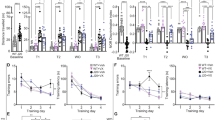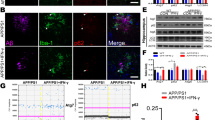Abstract
The pathology of Alzheimer's disease has an inflammatory component that is characterized by upregulation of proinflammatory cytokines, particularly in response to amyloid-β (Aβ). Using the APPPS1 Alzheimer's disease mouse model, we found increased production of the common interleukin-12 (IL-12) and IL-23 subunit p40 by microglia. Genetic ablation of the IL-12/IL-23 signaling molecules p40, p35 or p19, in which deficiency of p40 or its receptor complex had the strongest effect, resulted in decreased cerebral amyloid load. Although deletion of IL-12/IL-23 signaling from the radiation-resistant glial compartment of the brain was most efficient in mitigating cerebral amyloidosis, peripheral administration of a neutralizing p40-specific antibody likewise resulted in a reduction of cerebral amyloid load in APPPS1 mice. Furthermore, intracerebroventricular delivery of antibodies to p40 significantly reduced the concentration of soluble Aβ species and reversed cognitive deficits in aged APPPS1 mice. The concentration of p40 was also increased in the cerebrospinal fluid of subjects with Alzheimer's disease, which suggests that inhibition of the IL-12/IL-23 pathway may attenuate Alzheimer's disease pathology and cognitive deficits.
This is a preview of subscription content, access via your institution
Access options
Subscribe to this journal
Receive 12 print issues and online access
$209.00 per year
only $17.42 per issue
Buy this article
- Purchase on Springer Link
- Instant access to full article PDF
Prices may be subject to local taxes which are calculated during checkout





Similar content being viewed by others
References
Querfurth, H.W. & LaFerla, F.M. Alzheimer's disease. N. Engl. J. Med. 362, 329–344 (2010).
Steiner, H. & Haass, C. Intramembrane proteolysis by presenilins. Nat. Rev. Mol. Cell Biol. 1, 217–224 (2000).
Hardy, J. & Selkoe, D.J. The amyloid hypothesis of Alzheimer's disease: progress and problems on the road to therapeutics. Science 297, 353–356 (2002).
Ashe, K.H. & Zahs, K.R. Probing the biology of Alzheimer's disease in mice. Neuron 66, 631–645 (2010).
Streit, W.J., Mrak, R.E. & Griffin, W.S. Microglia and neuroinflammation: a pathological perspective. J. Neuroinflammation 1, 14 (2004).
Jucker, M. & Heppner, F.L. Cerebral and peripheral amyloid phagocytes—an old liaison with a new twist. Neuron 59, 8–10 (2008).
Grathwohl, S.A. et al. Formation and maintenance of Alzheimer's disease β-amyloid plaques in the absence of microglia. Nat. Neurosci. 12, 1361–1363 (2009).
Hickman, S.E., Allison, E.K. & El Khoury, J. Microglial dysfunction and defective β-amyloid clearance pathways in aging Alzheimer's disease mice. J. Neurosci. 28, 8354–8360 (2008).
Wyss-Coray, T. Inflammation in Alzheimer disease: driving force, bystander or beneficial response? Nat. Med. 12, 1005–1015 (2006).
Liesz, A. et al. Regulatory T cells are key cerebroprotective immunomodulators in acute experimental stroke. Nat. Med. 15, 192–199 (2009).
He, P. et al. Deletion of tumor necrosis factor death receptor inhibits amyloid β generation and prevents learning and memory deficits in Alzheimer's mice. J. Cell Biol. 178, 829–841 (2007).
Eisenring, M., vom Berg, J., Kristiansen, G., Saller, E. & Becher, B. IL-12 initiates tumor rejection via lymphoid tissue–inducer cells bearing the natural cytotoxicity receptor NKp46. Nat. Immunol. 11, 1030–1038 (2010).
Buonocore, S. et al. Innate lymphoid cells drive interleukin-23–dependent innate intestinal pathology. Nature 464, 1371–1375 (2010).
Radde, R. et al. Aβ42-driven cerebral amyloidosis in transgenic mice reveals early and robust pathology. EMBO Rep. 7, 940–946 (2006).
Magram, J. et al. IL-12–deficient mice are defective but not devoid of type 1 cytokine responses. Ann. NY Acad. Sci. 795, 60–70 (1996).
Mattner, F. et al. Genetically resistant mice lacking interleukin-12 are susceptible to infection with Leishmania major and mount a polarized Th2 cell response. Eur. J. Immunol. 26, 1553–1559 (1996).
Cua, D.J. et al. Interleukin-23 rather than interleukin-12 is the critical cytokine for autoimmune inflammation of the brain. Nature 421, 744–748 (2003).
Miners, J.S. et al. Aβ-degrading enzymes in Alzheimer's disease. Brain Pathol. 18, 240–252 (2008).
Greter, M. et al. Dendritic cells permit immune invasion of the CNS in an animal model of multiple sclerosis. Nat. Med. 11, 328–334 (2005).
Wu, C., Ferrante, J., Gately, M.K. & Magram, J. Characterization of IL-12 receptor β1 chain (IL-12Rβ1)-deficient mice: IL-12Rβ1 is an essential component of the functional mouse IL-12 receptor. J. Immunol. 159, 1658–1665 (1997).
Matthys, P. et al. Anti–IL-12 antibody prevents the development and progression of collagen-induced arthritis in IFN-γ receptor–deficient mice. Eur. J. Immunol. 28, 2143–2151 (1998).
Town, T., Tan, J., Flavell, R.A. & Mullan, M. T-cells in Alzheimer's disease. Neuromolecular Med. 7, 255–264 (2005).
Szekely, C.A. & Zandi, P.P. Non-steroidal anti-inflammatory drugs and Alzheimer's disease: the epidemiological evidence. CNS Neurol. Disord. Drug Targets 9, 132–139 (2010).
Trinchieri, G. Interleukin-12 and the regulation of innate resistance and adaptive immunity. Nat. Rev. Immunol. 3, 133–146 (2003).
Segal, B.M., Dwyer, B.K. & Shevach, E.M. An interleukin (IL)-10/IL-12 immunoregulatory circuit controls susceptibility to autoimmune disease. J. Exp. Med. 187, 537–546 (1998).
Romagnani, P., Annunziato, F., Baccari, M.C. & Parronchi, P. T cells and cytokines in Crohn′s disease. Curr. Opin. Immunol. 9, 793–799 (1997).
Ghoreschi, K., Weigert, C. & Rocken, M. Immunopathogenesis and role of T cells in psoriasis. Clin. Dermatol. 25, 574–580 (2007).
Guerreiro, R.J. et al. Peripheral inflammatory cytokines as biomarkers in Alzheimer′s disease and mild cognitive impairment. Neurodegener. Dis. 4, 406–412 (2007).
Rentzos, M. et al. Interleukin-12 is reduced in cerebrospinal fluid of patients with Alzheimer′s disease and frontotemporal dementia. J. Neurol. Sci. 249, 110–114 (2006).
Rota, E. et al. Increased intrathecal TGF-β1, but not IL-12, IFN-γ and IL-10 levels in Alzheimer′s disease patients. Neurol. Sci. 27, 33–39 (2006).
Hu, W.T. et al. Plasma multianalyte profiling in mild cognitive impairment and Alzheimer disease. Neurology 79, 897–905 (2012).
Town, T. et al. Reduced Th1 and enhanced Th2 immunity after immunization with Alzheimer′s β-amyloid(1–42). J. Neuroimmunol. 132, 49–59 (2002).
El Khoury, J. et al. Ccr2 deficiency impairs microglial accumulation and accelerates progression of Alzheimer-like disease. Nat. Med. 13, 432–438 (2007).
Town, T. et al. Blocking TGF-β-Smad2/3 innate immune signaling mitigates Alzheimer-like pathology. Nat. Med. 14, 681–687 (2008).
Butovsky, O. et al. Glatiramer acetate fights against Alzheimer's disease by inducing dendritic-like microglia expressing insulin-like growth factor 1. Proc. Natl. Acad. Sci. USA 103, 11784–11789 (2006).
Becher, B., Durell, B.G. & Noelle, R.J. IL-23 produced by CNS-resident cells controls T cell encephalitogenicity during the effector phase of experimental autoimmune encephalomyelitis. J. Clin. Invest. 112, 1186–1191 (2003).
Simard, A.R., Soulet, D., Gowing, G., Julien, J.P. & Rivest, S. Bone marrow–derived microglia play a critical role in restricting senile plaque formation in Alzheimer's disease. Neuron 49, 489–502 (2006).
Ireland, D.D. & Reiss, C.S. Expression of IL-12 receptor by neurons. Viral Immunol. 17, 411–422 (2004).
Lein, E.S. et al. Genome-wide atlas of gene expression in the adult mouse brain. Nature 445, 168–176 (2007).
Wyss-Coray, T. et al. Adult mouse astrocytes degrade amyloid-β in vitro and in situ. Nat. Med. 9, 453–457 (2003).
Koistinaho, M. et al. Apolipoprotein E promotes astrocyte colocalization and degradation of deposited amyloid-β peptides. Nat. Med. 10, 719–726 (2004).
Kauffman, C.L. et al. A phase I study evaluating the safety, pharmacokinetics, and clinical response of a human IL-12 p40 antibody in subjects with plaque psoriasis. J. Invest. Dermatol. 123, 1037–1044 (2004).
Gottlieb, A.B. et al. A phase 1, double-blind, placebo-controlled study evaluating single subcutaneous administrations of a human interleukin-12/23 monoclonal antibody in subjects with plaque psoriasis. Curr. Med. Res. Opin. 23, 1081–1092 (2007).
Mannon, P.J. et al. Anti–interleukin-12 antibody for active Crohn′s disease. N. Engl. J. Med. 351, 2069–2079 (2004).
Segal, B.M. et al. Repeated subcutaneous injections of IL12/23 p40 neutralising antibody, ustekinumab, in patients with relapsing-remitting multiple sclerosis: a phase II, double-blind, placebo-controlled, randomised, dose-ranging study. Lancet Neurol. 7, 796–804 (2008).
Heppner, F.L. et al. Experimental autoimmune encephalomyelitis repressed by microglial paralysis. Nat. Med. 11, 146–152 (2005).
Sahay, A. et al. Increasing adult hippocampal neurogenesis is sufficient to improve pattern separation. Nature 472, 466–470 (2011).
Kawarabayashi, T. et al. Age-dependent changes in brain, CSF, and plasma amyloid (β) protein in the Tg2576 transgenic mouse model of Alzheimer's disease. J. Neurosci. 21, 372–381 (2001).
Herzig, M.C. et al. Aβ is targeted to the vasculature in a mouse model of hereditary cerebral hemorrhage with amyloidosis. Nat. Neurosci. 7, 954–960 (2004).
Kornhuber, J. et al. Early and differential diagnosis of dementia and mild cognitive impairment: design and cohort baseline characteristics of the German Dementia Competence Network. Dement. Geriatr. Cogn. Disord. 27, 404–417 (2009).
Schipke, C.G., Prokop, S., Heppner, F.L., Heuser, I. & Peters, O. Comparison of immunosorbent assays for the quantification of biomarkers for Alzheimer's disease in human cerebrospinal fluid. Dement. Geriatr. Cogn. Disord. 31, 139–145 (2011).
Acknowledgements
This work was supported by the Deutsche Forschungsgemeinschaft (SFB TRR 43 to F.L.H. and NeuroCure Exc 257 to F.L.H. and Y.W.), the Swiss national science foundation (B.B.), the Koetzer foundation (B.B.), a NeuroCure Exc 257 visiting fellowship (B.B.), the US National Institutes of Health (NINDS R01 NS046006 to F.L.H.) and the European Union (FP7 HEALTH, Project LUPAS to F.L.H.). J.v.B. is a member of the Neuroscience Center Zurich, and F.M. is a member of the Molecular Life Sciences Zurich. We thank P. Matylewski, C. Hempt, C. Klatt and C. Gehlhaar for excellent technical help, F. Hiemeyer for performing the ANOVA statistics, K. Saeger for scanning and processing of histological mouse slides and M. Jucker, University of Tübingen, for generously providing APPPS1 mice.
Author information
Authors and Affiliations
Contributions
F.L.H. and B.B. conceived and jointly directed the study, designed the experiments and cowrote the manuscript. J.v.B. and S.P. designed and performed the experiments and cowrote the manuscript. S.P., K.R.M. and J.O. performed icv treatment and behavioral experiments. Y.W. provided conceptual assistance with behavioral experiments. R.E.K., I.L.-C. and A.W. provided technical and conceptual assistance for histological and biochemical analyses. C.G.S. and O.P. provided technical and conceptual assistance for biochemical analyses of human CSF samples. F.M. supported the FACS analyses. All authors read and approved the manuscript.
Corresponding authors
Ethics declarations
Competing interests
F.L.H and B.B. hold a patent application by the University of Zurich and the Charité–Universitätsmedizin Berlin entitled “Modulators of IL-12 and/or IL-23 for the Prevention or Treatment of Alzheimer's Disease” (PCT/EP2012/050066).
Supplementary information
Supplementary Text and Figures
Supplementary Figures 1–9 (PDF 2214 kb)
Rights and permissions
About this article
Cite this article
vom Berg, J., Prokop, S., Miller, K. et al. Inhibition of IL-12/IL-23 signaling reduces Alzheimer's disease–like pathology and cognitive decline. Nat Med 18, 1812–1819 (2012). https://doi.org/10.1038/nm.2965
Received:
Accepted:
Published:
Issue Date:
DOI: https://doi.org/10.1038/nm.2965
This article is cited by
-
Comparison of metabolic and neurological comorbidities in Asian patients with psoriasis and atopic dermatitis
Scientific Reports (2024)
-
The neuroimmune axis of Alzheimer’s disease
Genome Medicine (2023)
-
Myeloid cell deficiency of the inflammatory transcription factor Stat4 protects long-term synaptic plasticity from the effects of a high-fat, high-cholesterol diet
Communications Biology (2023)
-
Assessing causal relationship between circulating cytokines and age-related neurodegenerative diseases: a bidirectional two-sample Mendelian randomization analysis
Scientific Reports (2023)
-
Methamphetamine (MA) use and MA-induced psychosis are associated with increasing aberrations in the compensatory immunoregulatory system, interleukin-1α, and CCL5 levels
Translational Psychiatry (2023)



